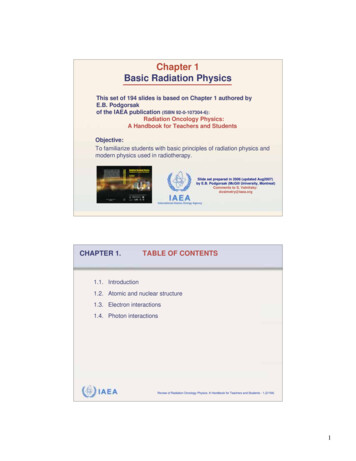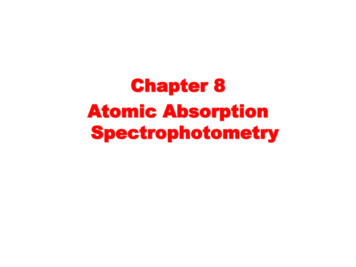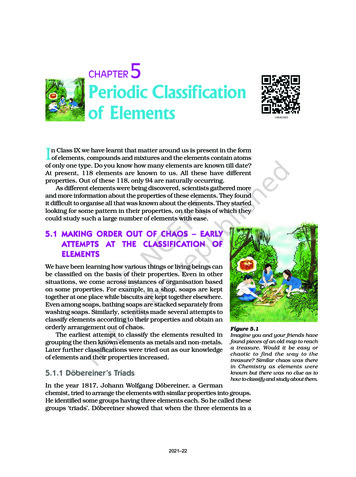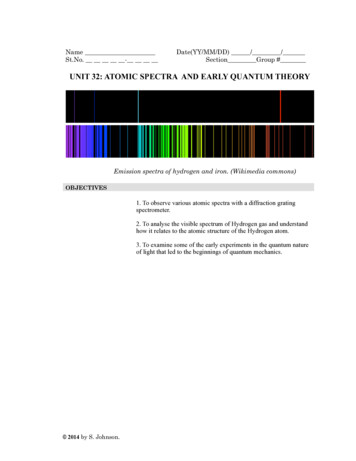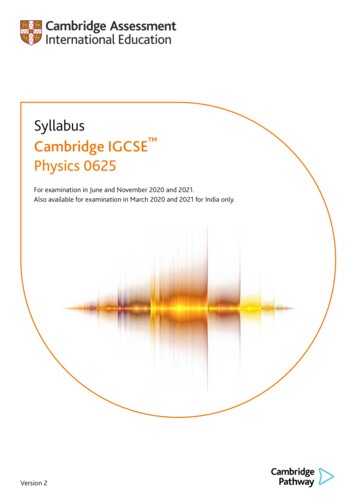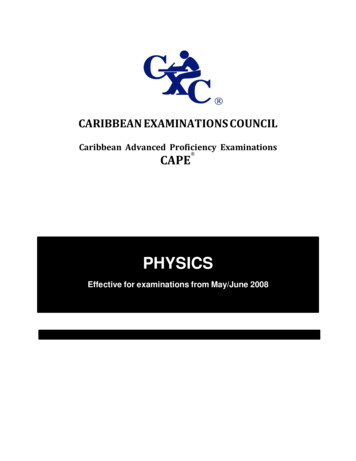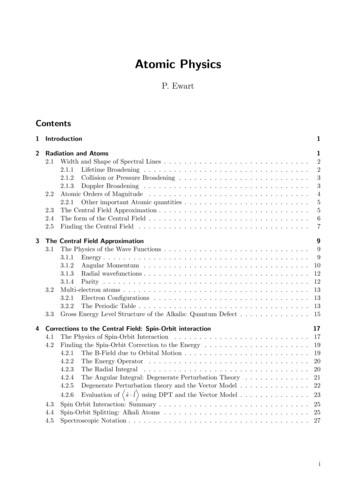
Transcription
Atomic PhysicsP. EwartContents1 Introduction12 Radiation and Atoms2.1 Width and Shape of Spectral Lines . . . .2.1.1 Lifetime Broadening . . . . . . . .2.1.2 Collision or Pressure Broadening .2.1.3 Doppler Broadening . . . . . . . .2.2 Atomic Orders of Magnitude . . . . . . .2.2.1 Other important Atomic quantities2.3 The Central Field Approximation . . . . .2.4 The form of the Central Field . . . . . . .2.5 Finding the Central Field . . . . . . . . .1223345567. . . . . . . . . . . . . . . . . . . . . . . . .Defect.999101212131313154 Corrections to the Central Field: Spin-Orbit interaction4.1 The Physics of Spin-Orbit Interaction . . . . . . . . . . . . . .4.2 Finding the Spin-Orbit Correction to the Energy . . . . . . . .4.2.1 The B-Field due to Orbital Motion . . . . . . . . . . . .4.2.2 The Energy Operator . . . . . . . . . . . . . . . . . . .4.2.3 The Radial Integral . . . . . . . . . . . . . . . . . . . .4.2.4 The Angular Integral: Degenerate Perturbation Theory4.2.5 Degenerate Perturbationtheory and the Vector Model .DE4.2.6 Evaluation of ŝ · ˆl using DPT and the Vector Model .4.3 Spin Orbit Interaction: Summary . . . . . . . . . . . . . . . . .4.4 Spin-Orbit Splitting: Alkali Atoms . . . . . . . . . . . . . . . .4.5 Spectroscopic Notation . . . . . . . . . . . . . . . . . . . . . . .171719192020212223252527.3 The Central Field Approximation3.1 The Physics of the Wave Functions . . . . .3.1.1 Energy . . . . . . . . . . . . . . . . .3.1.2 Angular Momentum . . . . . . . . .3.1.3 Radial wavefunctions . . . . . . . . .3.1.4 Parity . . . . . . . . . . . . . . . . .3.2 Multi-electron atoms . . . . . . . . . . . . .3.2.1 Electron Configurations . . . . . . .3.2.2 The Periodic Table . . . . . . . . . .3.3 Gross Energy Level Structure of the Alkalis:. . . . . . . . . . . . . . . . . . . . . . . . . . . . . . . . . . . . . . . . .Quantum.i
5 Two-electron Atoms: Residual Electrostatic Effects and LS-Coupling5.1 Magnesium: Gross Structure . . . . . . . . . . . . . . . . . . . . .5.2 The Electrostatic Perturbation . . . . . . . . . . . . . . . . . . . .5.3 Symmetry . . . . . . . . . . . . . . . . . . . . . . . . . . . . . . . .5.4 Orbital effects on electrostatic interaction in LS-coupling . . . . . .5.5 Spin-Orbit Effects in 2-electron Atoms . . . . . . . . . . . . . . . .6 Nuclear Effects on Atomic Structure6.1 Hyperfine Structure . . . . . . .6.2 The Magnetic Field of Electrons6.3 Coupling of I and J . . . . . . . .6.4 Finding the Nuclear Spin, I . . .6.5 Isotope Effects . . . . . . . . . .303031323334.3737383839407 Selection Rules427.1 Parity . . . . . . . . . . . . . . . . . . . . . . . . . . . . . . . . . . . . . . . . . . . . . 427.2 Configuration . . . . . . . . . . . . . . . . . . . . . . . . . . . . . . . . . . . . . . . . . 437.3 Angular Momentum Rules . . . . . . . . . . . . . . . . . . . . . . . . . . . . . . . . . . 438 Atoms in Magnetic Fields8.1 Weak field, no spin . . . . . . . . . . . . . .8.2 Weak Field with Spin and Orbit . . . . . .8.2.1 Anomalous Zeeman Pattern . . . . .8.2.2 Polarization of the radiation . . . . .8.3 Strong fields, spin and orbit . . . . . . . . .8.4 Intermediate fields . . . . . . . . . . . . . .8.5 Magnetic field effects on hyperfine structure8.5.1 Weak field . . . . . . . . . . . . . . .8.5.2 Strong field . . . . . . . . . . . . . .9 X-Rays: transitions involving inner shell electrons9.1 X-ray Spectra . . . . . . . . . . . . . . . . . .9.2 X-ray series . . . . . . . . . . . . . . . . . . .9.3 Fine structure of X-ray spectra . . . . . . . .9.4 X-ray absorption . . . . . . . . . . . . . . . .9.5 Auger Effect . . . . . . . . . . . . . . . . . . .10 High Resolution Laser Spectroscopy10.1 Absorption Spectroscopy . . . . . . . . .10.2 Laser Spectroscopy . . . . . . . . . . . .10.3 Spectral resolution . . . . . . . . . . . .10.4 “Doppler Free” spectroscopy . . . . . .10.4.1 Crossed beam spectroscopy . . .10.4.2 Saturation Spectroscopy . . . . .10.4.3 Two-photon-spectroscopy . . . .10.5 Calibration of Doppler-free Spectra . . .10.6 Comparison of “Doppler-free” 626262646565ii
Atomic Physics, P. Ewart1 Introduction1 IntroductionThe structure of atoms and how light interacts with them is responsible for the appearance of thevisible world. The small scale of atoms and the properties of nuclei and electrons required a new kindof mechanics to describe their behaviour. Quantum Mechanics was developed in order to explainsuch phenomena as the spectra of light emitted or absorbed by atoms. So far you have studied thephysics of hydrogen and helium as illustrations of how to apply Quantum Theory. There was a time,a few seconds after the Big Bang, when the Universe consisted only of hydrogen and helium nucleii.It took another 300,000 years for atoms, as such, to form. Things, however, have moved on and theuniverse is now a much more interesting place with heavier and more complicated atoms. Our aimis now to understand Atomic Physics, not just to illustrate the mathematics of Quantum Mechanics.This is both interesting and important, for Atomic Physics is the foundation for a wide range of basicscience and practical technology. The structure and properties of atoms are the basis of Chemistry,and hence of Biology. Atomic Physics underlies the study of Astrophysics and Solid State Physics. Ithas led to important applications in medicine, communications, lasers etc, as well as still providing atesting ground for Quantum Theory and its derivatives, Quantum Electrodynamics. We have learnedmost about atoms from the light absorbed or emitted when they change their internal state. So thatis a good place to begin.2 Radiation and AtomsWe will make extensive use of “models” in this course to help us get a feel for the physics. A favouritemodel for theorists is the “two-level atom” i.e. one with only two eigenstates ψ1 , ψ2 with energyeigenvalues E1 , E2 respectively (E2 E1 ). The wave functions have, in general, a time dependence.ψ1 φ1 (x)eiE1 t/ (1)iE2 t/ (2)ψ2 φ2 (x)eWhen the atom is perturbed it may be described by a wave function that is a linear combinationof ψ1 and ψ2 : ψ aψ1 bψ2 giving the probability amplitude. We observe, however, a probabilitydensity: the modulus squared; ψ 2 . This will have a termabψ1 ψ2 ei(E1 E2 )t/ (3)This is a time oscillating electron density with a frequency ω12 :ei(E1 E2 )t/ e iω12 t(4)E2 E1 ω12(5)SoThis is illustrated schematically in figure 1.1
Atomic Physics, P. Ewart2 Radiation and Atomsy1y2y(t) y1 y2Y(t t)Y(t)22IY(t)IIY(t t)IOscillating charge cloud: Electric dipoleFigure 1: Evolution of the wavefunction of a system with time.So the perturbation produces a charge cloud that oscillates in space – an oscillating dipole. Thisradiates dipole radiation. Whether or not we get a charge displacement or dipole will depend on thesymmetry properties of the two states ψ1 , and ψ2 . The rules that tell us if a dipole with be set upare called “selection rules”, a topic to which we will return later in the course.2.1 Width and Shape of Spectral LinesThe radiation emitted (or absorbed) by our oscillating atomic dipole is not exactly monochromatic,i.e. there will be a range of frequency values for ω12 . The spectral line observed is broadened byone, or more, processes. A process that affects all the atoms in the same way is called “Homogeneous Broadening”. A process that affects different individual atoms differently is “InhomogeneousBroadening”.Examples of homogeneous broadening are lifetime (or natural) broadening or collision (or pressure) broadening. Examples of inhomogeneous broadening are Doppler broadening and crystal fieldbroadening.2.1.1 Lifetime BroadeningThis effect may be viewed as a consequence of the uncertainty principle E t (6)Since E ω, E ω and if the time uncertainty t is the natural lifetime of the excited atomicstate, τ , we get a spread in frequency of the emitted radiation ω ω τ 1or ω 1τ(7)2
Atomic Physics, P. Ewart2 Radiation and AtomsThe lifetime, τ , is a statistical parameter related to the time taken for the population of the excitedstate to decay to 1/e of its initial value. This exponential decay is reflected in the experimentaldecay of the amplitude E(t) of the light wave emitted. The frequency (or power) spectrum of anexponentially decaying amplitude is a Lorentzian shape for the intensity as a function of frequencyI(ω) 1(ω ω0)2 (1/τ )2(8)The full width at half-maximum, FWHM, is then 1 ω 2τ(9)A typical lifetime τ 10 8 sec.Number of excited atomsN(t)Intensity spectrumI(w)frequency, wTime, tLorentzian lineshapeExponential decayFigure 2: Decay of excited state population N (t) leads to similar exponential decay of radiationamplitude, giving a Lorentzian spectrum.2.1.2 Collision or Pressure BroadeningA collision with another atom while the atom is radiating (oscillating) disrupts the phase of thewave. The wave is therefore composed of various lengths of uninterrupted waves. The numberof uninterrupted waves decays exponentially with a 1/e time τc , which is the mean time betweencollisions. At atmospheric pressure this is typically 10 10 sec. The exponential decay of thecoherent oscillations again leads to a Lorentzian lineshape.Intensity spectrumNumber of uncollided atomsN(t)I(w)Time, tExponential decayfrequency, wLorentzian lineshapeFigure 3: Decay in number of undisturbed atoms radiating leads to decay in amplitude of waveundisturbed by a phase changing collision. The associated frequency spectrum is againLorentzian.2.1.3 Doppler BroadeningAtoms in a gas have a spread of speeds given by the Maxwell-Boltzmann distribution. The Dopplershift of the light emitted is therefore different for the atoms moving at different speeds. There is then3
Atomic Physics, P. Ewart2 Radiation and Atomsa spread of Doppler shifted frequencies leading to a broadening of the spectral line. Since differentatoms are affected differently this Doppler Broadening is “Inhomogeneous broadening”. The Dopplershift is given by: v ω ω0 1 (10)cThe spread, or width of the line, is therefore ωD ω0vc(11)Since ω0 1015 rad s 1 and v 102 ms 1 we find ωD 2π109 rad s 19 ν 10 HzDistribution of atomic speedN(v)(12)(13)Doppler broadeningI(w)atomic speed, vMaxwell-Boltzmanndistributionfrequency, wGaussian lineshapeFigure 4: Maxwell-Boltzmann distribution of speeds and the associated Doppler broadening giving aGaussian lineshape.2.2 Atomic Orders of MagnitudeWe have already started getting a feel for typical values of parameters associated with spectral lines,so now is a good time to do the same for some other aspects of atoms. It is important to have someidea of the orders of magnitude associated with atoms and their structure. We will be looking atatoms more complex than Hydrogen and Helium for which we can’t solve the Schrodinger Equationexactly. We have to do the best we can with approximate solutions using Perturbation Theory. Sowe need to know when perturbation theory will give a reasonable answer. We will be particularlyinterested in the energy level structure of atoms so let’s start there.First a word about units. Atoms are small 10 10 m and their internal energies are small; 10 19Joule. So a Joule is an inconvenient unit. We will use electron Volts, eV, which is 2 10 19 J. Wehave seen that atoms emit or absorb light in the UV or visible range – say 500 nm. This must thenbe of the order of the energy changes or binding energy of the outer, most loosely bound electron.Now a wavelength λ 500 nm corresponds to a frequency, ν 6 1014 Hz. So from E hν wefind E 40 10 34 1014 4 10 19 J 2eV.We could also check this using the size of an atom ( 10 10 m) using the Uncertainty Principle. p x x 2 /(2m) a few eV x(14) p p (15)p22m(16)E 4
Atomic Physics, P. Ewart2 Radiation and AtomsWe can compare 2 eV with thermal energy or kT i.e. the mean Kinetic energy available from1heat, 40eV. This is not enough to excite atoms by collisions so atoms will mostly be in their groundstate.2.2.1 Other important Atomic quantitiesAtomic size: Bohr radiusa0 4π 0 2 0.53 10 10 mme2(17)me4 13.6 eV(4π 0 )2 2 2(18)Ionisation Energy of HydrogenEH Rydberg constantEH 1.097 107 m 1hcR is useful is relating wavelengths λ to energies of transitions since wavenumber ν̄ m 1 .R (19)1λin units ofFine structure constante21 (20)4π 0 c137This is a dimensionless constant that gives a measure of the relative strength of the electromagneticforce. It is actually also the ratio of the speed ve of the electron in the ground state of H to c, thespeed of light. α ve /c and so it is a measure of when relativistic effects become important.α Bohr magnetone 9.27 10 24 JT 1(21)2mThis is the basic unit of magnetic moment corresponding to an electron in a circular orbit withangular momentum , or one quantum of angular momentum.As well as having orbital angular momentum the electron also has intrinsic spin and spin magneticmoment µS 2µB . A proton also has spin but because its mass is 2000 larger than an electronits magnetic moment is 2000 times smaller. Nuclear moments are in general 2000 times smallerthan electron moments.µB 2.3 The Central Field ApproximationWe can solve the problem of two bodies interacting with each other via some force e.g. a star andone planet with gravitational attraction, or a proton and one electron – the hydrogen atom. If weadd an extra planet then things get difficult. If we add any more we have a many body problemwhich is impossible to solve exactly. Similarly, for a many electron atom we are in serious difficulty– we will need to make some approximation to simplify the problem. We know how to do Hydrogen;we solve the Schrödinger equation: Ze2 2 2 ψ ψ Eψ2m4π 0 r(22)We can find zero order solutions – wave functions ψ that we can use to calculate smaller perturbationse.g. spin-orbit interaction.5
Atomic Physics, P. Ewart2 Radiation and AtomsThe Hamiltonian for a many electron atom however, is much more complicated. XN Xe2 2 2Ze2 Ĥ i 2m4π 0 ri4π 0 rij(23)i ji 1We ignore, for now, other interactions like spin-orbit. We have enough on our plate! The secondterm on the r.h.s. is the mutual electrostatic repulsion of the N electrons, and this prevents us fromseparating the equation into a set of N individual equations. It is also too large to treat as a smallperturbation.We recall that the hydrogen problem was solved using the symmetry of the central Coulomb field –the 1/r potential. This allowed us to separate the radial and angular solutions. In the many electroncase, for most of the time, a major part of the repulsion between one electron and the others actstowards the centre. So we replace the 1/r, hydrogen-like, potential with an effective potential due tothe nucleus and the centrally acting part of the 1/rij repulsion term. We call this the Central FieldU (r). Note it will not be a 1/r potential. We now write the HamiltonianĤ Ĥ0 Ĥ1 X 22 where Ĥ0 U (ri )2m ii X e2X Ze2and Ĥ1 U (ri )4π 0 rij4π 0 rii j(24)(25)(26)iĤ1 is the residual electrostatic interaction. Our approximation is now to assume Ĥ1 Ĥ0 andthen we can use perturbation theory.The procedure is to start with just Ĥ0 . Since this is a central potential the equations are separable.Solutions for the individual electrons will have the form:0(r)Ylm (θ, φ)χ(ms )ψ(n, l, ml , ms ) Rn,l(27)So far, in this approximation the angular functions Ylm (θ, φ) and spin functions χ(ms ) will be thesame as for hydrogen. The radial functions will be different but they will have some features of thehydrogenic radial functions. The wave function for the whole atom will consist of antisymmetricproducts of the individual electron wave functions. The point is that we can use these zero orderwavefunctions as a basis set to evaluate the perturbation due to the residual electrostatic interactionsĤ1 . We can then find new wavefunctions for the perturbed system to evaluate other, presumedsmaller, perturbations such as spin-orbit interaction. When it comes to the test we will have todecide in any particular atom, which is the larger of the two perturbations – but more of that later.2.4 The form of the Central FieldCalculating the form of U (ri ) is a difficult problem. We can, however, get a feel for the answer intwo limiting situations. Firstly, imagine one electron is taken far away from the nucleus, and theother electrons. What form of potential will it see? Clearly, there are then Z protons surroundedapparently by Z 1 electrons in a roughly spherically symmetric cloud. Our electron then sees, atlarge r, a Hydrogen-like 1/r potential. Secondly, what happens when our electron goes “inside” thecloud of other electrons? Here, at small r, it sees Z protons and feels a Z/r potential.The potential then looks like it has the formU (r) Zeff (r)e24π 0 r(28)Where Zeff (r) varies from Z at small r to 1 at large r.Note, for most of the important space U (r) is not a 1/r potential.6
Atomic Physics, P. Ewart2 Radiation and Atomsr1/rU(r) Z/r“Actual”PotentialFigure 5: “Actual” potential experienced by an electron behaves like 1/r at large r and Z/r for smallr. The intermediate r case is somewhere between the two.Zeff Z1Radial position, rFigure 6: The variation of the effective Z that the electron feels as a function of r.2.5 Finding the Central FieldThe method of finding a good approximation to the Central Field is based on a “Self consistent field”.This was first done by Hartree and his method was further developed by Fock so that we now call itthe Hartree-Fock method. Hartree’s basic idea was to find the best form of the potential by a seriesof iterations based on some initial guess. It works as follows.(1) Guess a “reasonable” form for U (r)(2) Put this guess for U (r) into the Schrodinger equation and solve to find approximate wavefunctions(3) Use these wave functions to calculate the charge distribution of the electrons(4) Find the potential set up by this charge distribution and see if it matches the original guessfor U (r).(5) Iterate this procedure until a self-consistent solution is found.This procedure is ideally suited to numerical solution by a computer. The solutions for thewavefunctions will therefore be numerical i.e. they can’t be expressed by nice analytical formulae. Hartree’s orginal method used simple product wavefunctions which were not correctly antisymmetric. Each of the electrons in this model move in a potential set up by the other electronsand, as a result, the potentials are not the same for all the electrons and so the individual electron7
Atomic Physics, P. Ewart2 Radiation and Atomsstates are not automatically orthogonal. The Hartree-Fock method uses an anti-symmetric basisset of wavefunctions. These are constructed using determinants where columns represent quantumstates of individual electrons. This means that interchanging any column automatically changes thesign and makes the states correctly antisymmetric. The product states for each electron containboth space and spin functions. The potential is assumed to be the same for all the electrons. Thepotential is varied so as to produce the minimum energy for the system. This is the VariationalPrinciple and has the same effect as finding a self-consistent field. The Hartree-Fock method is nowthe most commonly used way of finding wave functions and energy levels for many electron atoms.The wavefunctions produced are again numerical rather than analytic.8
Atomic Physics, P. Ewart3 The Central Field Approximation3 The Central Field ApproximationTo recap, we have lumped together the Coulomb attraction of the Z protons in the nucleus with thecentrally acting part of the mutual electrostatic repulsion of the electrons into U (r). This CentralField goes like 1/r at large r and as Z/r at small r.At in-between values of r things are more complicated – but more interesting! The importantpoint is that we can, in many cases, treat the residual electrostatic interaction as a perturbation, sothe Hamiltonian for the Schrödinger equation will beĤ Ĥ0 Ĥ1 Ĥ2 .(29)Ĥ1 will be the perturbation due to residual electrostatic interactions, Ĥ2 that due to spin-orbitinteractions. We will mostly deal with the cases where Ĥ1 Ĥ2 but this won’t be true for allelements. We can also add smaller perturbations, Ĥ3 etc due to, for example, interactions withexternal fields, or effects of the nucleus (other than its Coulomb attraction). The Central FieldApproximation allows us to find solutions of the Schrödinger equation in terms of wave functions ofthe individual electrons:ψ(n, l, ml , ms )(30)The zero-order Hamiltonian Ĥ0 due to the Central Field will determine the gross structure of theenergy levels specified by n, l. The perturbation Ĥ1 , residual electrostatic, will split the energy levelsinto different terms. The spin orbit interaction, Ĥ2 further splits the terms, leading to fine structureof the energy levels. Nuclear effects lead to hyperfine structures of the levels.Within the approximation we have made, so far, the quantum numbers ml , ms do not affect theenergy.The energy levels are therefore degenerate with respect to ml , ms . The values of ml , ms orany similar magnetic quantum number, specify the state of the atom.There are 2l 1 values of ml i.e. 2l 1 states and the energy level is said to be (2l 1)-folddegenerate. The only difference between states of different ml (or ms ) is that the axis of theirangular momentum points in a different direction in space. We arbitrarily chose some z-axis so thatthe projection on this axis of the orbital angular momentum l would have integer number of units(quanta) of . (ms does the same for the projection of the spin angular momentum s on the z-axis).(Atomic physicists are often a bit casual in their use of language and sometimes use the words energy level, and state (e.g. Excited state or ground state) interchangeably. This practice is regrettablebut usually no harm is done and it is unlikely to change anytime soon.)3.1 The Physics of the Wave FunctionsYou will know (or you should know!) how to find the form of the wave functions ψ(n, l, ml , ms ) inthe case of atomic hydrogen. In this course we want to understand the physics – the maths is done inthe text books. (You may like to remind yourself of the maths after looking at the physics presentedhere!) Before we look at many electron atoms, we remind ourselves of the results for hydrogen.3.1.1 EnergyThe energy eigenvalues, giving the quantized energy levels are given by:EDEn ψn,l,ml Ĥ ψn,l,ml Z 2 me4(4π 0 )2 2 2 n2(31)(32)Note that the energy depends only on n, the Principal quantum number. The energy does not dependon l – this is true ONLY FOR HYDROGEN! The energy levels are degenerate in l. We representthe energy level structure by a (Grotrian) diagram.9
Atomic Physics, P. Ewart3 The Central Field Approximationl 00s1p2dn432Energy-13.6 eV1Figure 7: Energy level structure of hydrogen, illustrating how the bound state energy depends on nbut not l.For historical reasons, the states with l 0, 1, 2 are labelled s, p, d. For l 3 and above the labelsare alphabetical f, g, h etc.3.1.2 Angular MomentumThe wavefunction has radial and angular dependence. Since these vary independently we can write:ψn,l,ml (r, θ, φ) Rn,l (r)Ylml (θ, φ)Rn,l (r) and Ylml are radial and angular functions normalized as follows:ZZ222Ylml (θ, φ) dΩ 1Rn,l (r)r dr 1(33)(34)The angular functions are eigenfunctions of the two operators ˆl2 and ˆlz :ˆl2 Y ml (θ, φ) l(l 1) 2 Y ml (θ, φ)llˆlz Y ml (θ, φ) ml Y ml (θ, φ)ll(35)(36)Where l(l 1) and ml are the eigenvalues of ˆl2 and ˆlz respectively, such thatl 0, 1, 2.(n 1) l ml l(37)The spin states of the electron can be included in the wave function by multiplying by a spinfunction χs which is an eigenfunction both of ŝ2 and ŝz with eigenvalues s(s 1) and ms respectively.(s 1/2 and ms 1/2)Roughly speaking, the angular functions specify the shape of the electron distribution and theradial functions specify the size of the orbits.l 0, s-states, are non-zero at the origin (r 0) and are spherically symmetric. Classicallythey correspond to a highly elliptical orbit – the electron motion is almost entirely radial. Quantummechanically we can visualise a spherical cloud expanding and contracting – breathing, as the electronmoves in space.10
Atomic Physics, P. Ewart3 The Central Field Approximationl 1. As l increases, the orbit becomes less and less elliptical until for the highest l (n 1) theorbit is circular. An important case (i.e. worth remembering) is l 1 (ml 1, 0)Y11Y1 1Y100 Y1 (q,f) 2(a) 38π 1/2sin θeiφ(38) 3 1/2sin θe iφ 8π 1/23 cos θ4π Y1 (q,f) (39)(40)2(b)Figure 8: The angular functions, spherical harmonics, giving the angular distribution of the electronprobability density.If there was an electron in each of these three states the actual shapes change only slightly togive a spherically symmetric cloud. Actually we could fit two electrons in each l state provided theyhad opposite spins. The six electrons then fill the sub-shell (l 1) In general, filled sub-shells arespherically symmetric and set up, to a good approximation, a central field.As noted above the radial functions determine the size i.e. where the electron probability ismaximum.11
Atomic Physics, P. Ewart3 The Central Field Approximation3.1.3 Radial wavefunctions21.010.5246 Zr/ao2468 Zr/a 10o1st excited state, n 2, l 0n 2, l 1Ground state, n 1, l 00.4246810Zr/ao202nd excited state, n 3, l 0n 3, l 1n 3, l 2Figure 9: Radial functions giving the radial distribution of the probability amplitude.NB: Main features to remember! l 0, s-states do not vanish at r 0. l 6 0, states vanish at r 0 and have their maximum probability amplitude further out withincreasing l. The size, position of peak probability, scales with n2 . The l 0 function crosses the axis (n 1) times ie. has (n 1) nodes. l 1 has (n 2) nodes and so on. Maximum l n 1 has no nodes (except at r 0)3.1.4 ParityThe parity operator is related to the symmetry of the wave function. The parity operator takesr r. It is like mirror reflection through the origin.θ π θand φ π φ(41)If this operation leaves the sign of ψ unchanged the parity is even. If ψ changes sign the parity isodd. Some states are not eigenstates of the parity operator i.e. they do not have a definite parity.The parity of two states is an important factor in determining whether or not a transition betweenthem is allowed by emitting or absorbing a photon. For a dipole transition the parity must change.12
Atomic Physics, P. Ewart3 The Central Field ApproximationIn central fields the parity is given by ( 1)l . So l 0, 2 even states, s, d etc. are even parity andl 1, 3, odd states are odd parity. Hence dipole transitions are allowed for s p or p d, but notallowed for s s or s d.3.2 Multi-electron atoms3.2.1 Electron ConfigurationsBefore considering details about multi-electron atoms we make two observations on the Central FieldApproximation based on the exact solutions for hydrogen.Firstly, for a central field the angular wave functions will be essentially the same as for hydrogen.Secondly, the radial functions will have similar properties to hydrogen functions; specifically theywill have the same number of nodes.The energy level-structure for a multi-electron atom is governed by two important principles:a) Pauli’s Exclusion Principle andb) Principle of Least EnergyPauli forbids all the electrons going into the lowest or ground energy level. The Least Energyprinciple requires that the lowest energy levels will be filled first. The n 1, l 0 level can take amaximum of two electrons. The least energy principle then means the next electron must go into thenext lowest energy level i.e. n 2. Given that l can take values up to n 1 and each l-value canhave two values of spin, s, there are 2n2 vacancies for electrons for each value of n. Our hydrogensolutions show that higher n values lead to electrons having a most probable position at larger valuesof r. These considerations lead to the concept of shells, each labelled by their value of n.Now look at the distribution of the radial probability for the hydrogenic wave functions Rn,l (r). Thelow angular momentum states, especially s-states have the electrons spending some time inside theorbits of lower shell electrons. At these close distances they are no longer screened from the nucleus’Z protons and so they will be more tightly bound than their eq
is now to understand Atomic Physics, not just to illustrate the mathematics of Quantum Mechanics. This is both interesting and important, for Atomic Physics is the foundation for a wide range of basic science and practical technology. The structure and properties of atoms are the basis of Chemistry, and hence of Biology.

